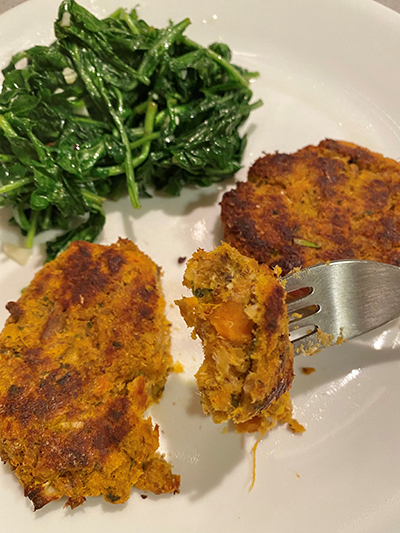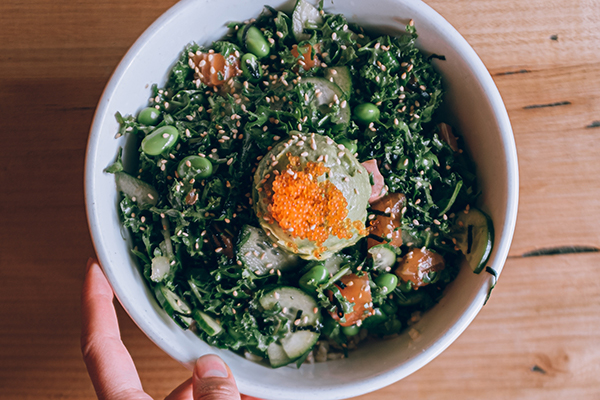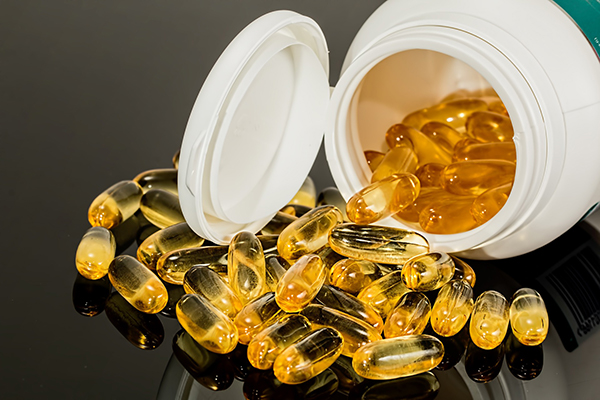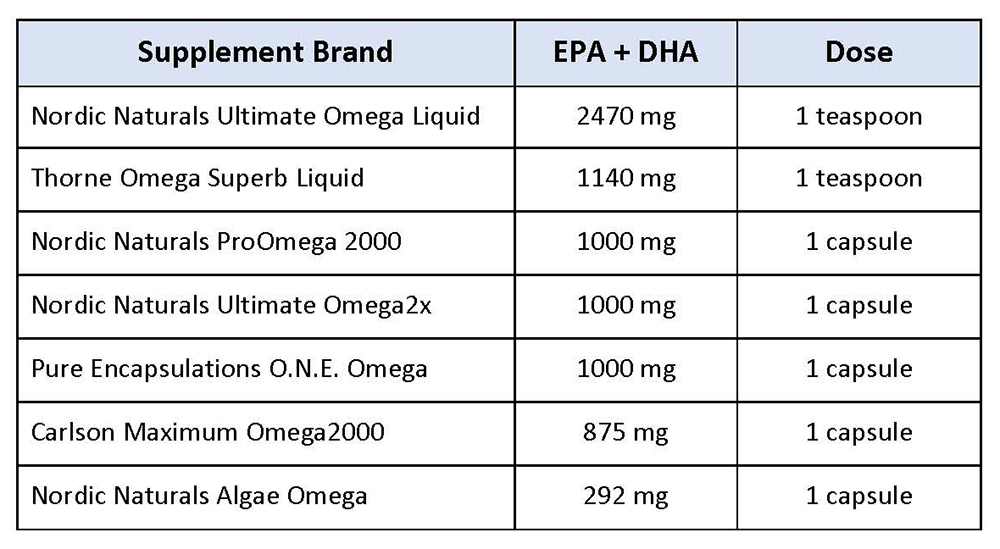Omega-3 fatty acids are essential fats, meaning that we must get them from our diet because our body cannot make them. There are 3 main types of omega-3 fatty acids: EPA (eicosapentaenoic acid), DHA (docosahexaenoic acid) and ALA (alpha-linolenic acid).
Found mostly in fatty fish, EPA and DHA play a major role in many aspects of our health. They are needed for structure and function of basically every cell in the body and are critical for brain development and function, eye health, cardiovascular function, hormone production and reducing inflammation.
Derived from plants, ALA doesn’t have the same potent anti-inflammatory actions as EPA and DHA. However, it’s still an essential fat that is important for our health, and studies show that ALA may have neuroprotective and anti-depressant properties.
How much do I need?
For the general population, the American Heart Association recommends at least two 3 ounce servings of omega-3 rich fish per week to meet EPA + DHA needs. For those with heart disease, some experts recommend 4 servings per week.
The U.S. Institute of Medicine recommends 1.6 grams of ALA per day for men and 1.1 grams per day for women. Note: Our bodies can convert ALA to EPA and DHA, but the conversion rate is thought to be only between 0-10%, depending on many factors. You cannot rely on ALA intake to satisfy your EPA and DHA needs.
Food sources of EPA + DHA mostly include: fatty fish such as salmon, sardines, mackerel, herring, anchovies and rainbow trout. There can be small amounts of omega-3 fats found in other seafoods as well as pasture-raised eggs, and grass-fed beef and dairy products.
Food sources of ALA include: flax seeds, chia seeds, walnuts, and hemp seeds. Various other nuts, seeds and seed oils contain smaller amounts of ALA.
Omega-3 fatty acids are not optional! Learn what they are used for and where to find them. #saslife Click To TweetWhat if I hate seafood?
If you can’t stand that fishy smell or just don’t like seafood for any reason, supplements can be one option. I would highly encourage you to keep trying salmon, sardines or other omega-3 rich fish and seafood since they offer much more than just EPA and DHA. Most seafood is not only rich in protein, but also B vitamins, selenium, magnesium, potassium, zinc and many other nutrients.
Here are some tips to help you start to learn to like seafood:
- Either buy really fresh, like caught that day, or buy frozen. The older the fish the fishier it will smell and taste.
- Start out with mild white meat seafood like rainbow trout, flounder, halibut, shrimp, scallops and Chilean sea bass — they also take up marinades and spices easily.
- Try it raw. The texture of raw fish, like salmon sushi, for example is smooth rather than flaky. Plus, if you load it with the pickled ginger and wasabi, you won’t even taste it. Ha!
- Don’t feel like you have to make it the main attraction to your meal. Start with adding small amounts to things you already like, or make meals that have many other components like spaghetti, fajitas or fisherman’s eggs.
- Use spices, and lots of them. The spices can help mask the flavor until you get used to it.
- Use lemon or lime. Both can help to mask or neutralize the fishy flavor.
- Try smoked salmon. Tastes like bacon.
- Dip it in something. This goes along with the spice tip, it can help to mask the flavor. Make patties (see recipe below too) or even crusted fish and dip in ketchup, tartar sauce, awesome sauce, etc.
- Don’t overcook it. I know it’s tricky when you are first learning to cook something, but this will make a huge difference. Check your fish early and often.
What if I’m allergic to fish?
Nordic Naturals Algae Omega is an algae-based vegan EPA/DHA product, free of fish.
Supplemental Omega-3
Supplemental EPA and DHA may be necessary if you don’t consume adequate amounts from food or if you are trying to reach a therapeutic level. For overall health a reasonable goal is 1 gram of EPA and DHA daily. Therapeutically, EPA and DHA can be beneficial for many different conditions.
Studies have found that taking EPA + DHA can lower the risk of coronary heart disease (CHD) and myocardial infarction (MI). They found that the risk reduction is dose dependent – meaning the more you take the lower your risk, to a certain extent. EPA and DHA can decrease LDL particle number, increase particle size (to the less dangerous large, fluffy LDL particles) and decrease triglycerides.
There is a substantial amount of research around omega-3 intake and brain health, specifically with depression and anxiety. Studies have found benefits of omega-3 supplement intake with many neurological and psychiatric disorders.
Since omega-3 supplements have also been shown to reduce chronic inflammation, they can be helpful in many other conditions as well. They can positively impact our gut microbiota, improve how our immune system responds (benefiting autoimmune conditions such as rheumatoid arthritis and inflammatory bowel disease) and reduce gastrointestinal inflammation, to name a few.
Talk to your dietitian/nutritionist or healthcare provider about the specific dose that is right for you.
Quality Concerns
Contamination and rancidity are two major concerns with omega-3 supplements. Fish can accumulate toxins such as mercury, dioxins and polychlorinated biphenyls (PCBs). These sensitive oils are also highly susceptible to oxidation which can decrease the safety and effectiveness. Purchasing supplements from a high quality, reputable company is very important.
While you can sometimes tell that a fish oil is rancid when you take it directly as a liquid, it can be masked by added flavors and it would not be easily detected if you use a softgel or other encapsulated product.
Keep your omega-3 supplements in the refrigerator to help prevent oxidation, and if you order them online, make sure they do not sit outside in the heat when they are delivered!
If you won’t be using the fish oil quickly, you can also freeze it. This will extend its freshness and not have an adverse effect on the oil (and generally will not affect capsules either).
The form of the supplement also has an impact on absorption. EPA and DHA supplements are typically either in ethyl ester or triglyceride forms. Studies show that the triglyceride form is best absorbed, with up to 76% greater absorption than the ethyl ester form.
When choosing an omega-3 supplement, consider the purity, freshness and form. We recommended trying one of the following high-quality brands to ensure you are getting a safe, effective product.
Oven Fried Salmon and Sardine Cakes
Serves 2-4
Recipe adapted from Melissa Joulwan's Well Fed
PRINT RECIPE

Ingredients
- 1 (6 oz) can wild-caught pink or red salmon, drained
- 2 (3.75 oz) cans sardines in olive oil or water, drained
- 1 cup cooked mashed sweet potato
- 2 large eggs, beaten (I used 1 Tbsp ground flax mixed with 2 Tbsp water)
- ½ cup almond flour
- ½ cup fresh parsley leaves, minced (about 2 Tbsp)
- 2 scallions, white and green parts, very thinly sliced
- 1 Tbsp Old Bay Seasoning
- 1 tsp salt
- 1 tsp hot sauce
- ½ tsp paprika
- ¼ tsp ground black pepper
- zest from 1 lemon
- 2 Tbsp grass-fed butter or ghee, melted
- Garnish options: Awesome Sauce, Sriracha Sauce or any spicy mayo type dip
Directions
- Preheat oven to 425ºF and cover a large baking sheet with parchment paper.
- Crumble the fish into a large mixing bowl. Add the sweet potato, eggs, almond flour, parsley, scallions, Old Bay Seasoning, salt, hot pepper sauce, paprika, black pepper, and lemon zest. Mix well and refrigerate for 10 minutes.
- Brush parchment paper with some of the melted butter or ghee, then use a ⅓ measuring cup to scoop the cakes and drop them onto the parchment. The patties should be about 2 ½ inches wide and about 1 inch thick.
- Brush the tops of the cakes with the remaining butter or ghee, then bake for 20 minutes. Carefully flip each patty with a spatula and return to the oven. (Brush with more butter or ghee, if needed.)
- Bake an additional 10 minutes until golden brown and crisp.
- Serve with a squeeze of lemon juice and your sauce of choice.







